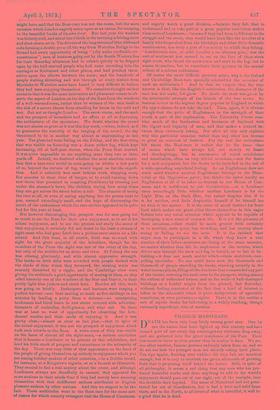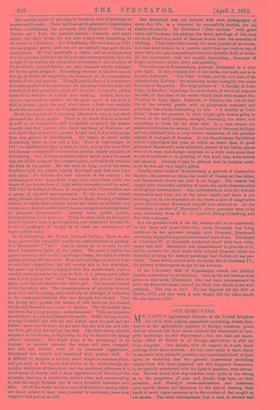VILUELM MARSTRAND.
The modern school of painting in Denmark calls Eckersberg its master and founder. There had been good painters in Copenhagen before,—Abildgaard, the pompous and allegorical "father of Danish art ;" Juul, the portrait-painter ; Carstens, and many others ; but their works are not now-a-days very interesting, at all events to a foreigner. But Eckersberg, who was born in 1783, was an original genius, and cut out an entirely new path for his countrymen. He was essentially a realist, and so overpowering was his personal influence on his younger contemporaries, that the weight of his realism has completely overbalanced the idealism of Thorwaldsen, and led Danish art into channels wholly unsought for by the great sculptor. Eckersberg was one of the first men in Europe to throw off completely the trammels of the conventional schools of the last century. What Reynolds effected in portraiture Eckersberg effected in landscape ; he did away with the buhl and ormolu that had passed for colour till his time ; to him the golden tones of the disciples of Claude were nothing. Indeed, he is too opaque, too severe in outline ; but the great merit of his work is that in it once again the cool wind blows, a fresh clear sunlight floods the air, and a real sea is broken into real and credible waves.
Of all the scholars of Eckersberg, Marstrand, who is just dead, possessed the finest genius. There is no doubt that in technical as well as in imaginative skill he greatly surpassed the master himself, and few persons who know anything of Northern art will doubt that he rose to a greater height and had a wider scope than any painter of Scandinavia. He began to study under Eckersberg while he was still a boy. Born at Copenhagen in 1810, he exhibited his first picture in 1829, and by the year 1836 had become a respectable second-class painter, closely imitative of Eckersberg. One of those accidents which decide men's lives took him out of the range of the common-place, and suddenly revealed the bent of his genius. He was sent to Italy, and in the warm Southern light his powers rapidly developed and took now form and scope. He became the best colourist of his country ; his pictures glow with warm fresh tones, and everywhere there are traces of the intense love of Italy which interpenetrated his mind. Till 1841 he worked at Rome, in company with Thorwaldsen and a group of talented contemporaries. In the year 1840 almost every Danish artist of importance was in Rome, forming a brilliant coterie, in which characteristic talent was under no restraint, and 'where every kind of individuality was encouraged and strengthened by generous circumstances. Among these golden youths, Marstrand was facile prineeps. When he came back to his native land he became, first, a genre-painter, and illustrated Danish life in the Copenhagen of to-day by at least one masterpiece of transcendent value.
In Kristiansborg, the Danish National Gallery, there is one large picture that irresistibly constrains one's attention in passing. It is Marstrand's "Visit." One is drawn to it at once by the broad, harmonious lustre of the colour. The scene is laid in the guest-room of a well-to-do Copenhagen house; the light of a fresh spring morning fills the room. Four principal figures unite to form an excellent composition ; the old mother sits in her arm-chair, her grown-up daughter is engaged with her needle-work, while a smaller sister pauses in her play to look at a young naval officer who is just paying the " visit" from which the picture takes its name, and who sits close to the eldest girl. The moment chosen is the first silent one. The common-places of greeting have all been said, and the young man, evidently no stranger, is reflecting on the momentous business that has brought him thither. That the young lady guesses the nature of this business, her flashed cheeks and downcast eyes seem to declare. The old mother does not share the young people's embarrassment. With an exquisite nonchalance, she sits and threads her needle. While this one needle is being threaded, she will sit and reflect upon the past and the future ; when that is done, we are sure that she will rise and take the little girl with her and go her way. The little sister, already surprised at the silence, is beginning to try to distract the young officer's attention. The whole work is the photograph of an instant ; in another moment the action will have changed, but this one instant, with all its humorous suggestions, Marstrand has caught and translated with perfect skill. It is difficult to imagine a subject more simple or common-place, and yet, such is the vigour and charm of the workmanship, the peculiar loveliness of the colour, and the combined influences of a vivid sense of beauty and a keen appreciation of the fun of the situation, that one is irresistibly carried away and conquered by it, and its image becomes one of one's favourite memories ever after. Of all the works we have seen of this master, among which are many nobler in aim, more poetical in sentiment, none is so complete and perfect as this. But Mantra:ud was not content with such photography of every-day life ; as a humorist he successfully studied the old classic& of comedy. He illustrated "Don Quixote" with great verve and liveliness, hut perhaps his finest paintings of this class are to be found in a series of famous 'scenes from the comedies of Heiberg. These have been among the most populer of his works, and that must indeed be a pensive spirit that can look on one of these witty and gay compositions without a sensible thrill of mirth. To the connoisseur they are equally fascinating; bouquets of bright and sunny colour, dewy and sparkling.
The collection at Kristiansborg presents Maratrand in a very good light. It only contains five of his works, but each one is in his very best style. "The Visit" is there, and the two beat of his episodes from Hedberg; the remaining works exemplify two more branches of his genius. The large picture of "A Sunday at Lake Siljan, in Sweden," is perhaps the most showy, if not in all respects the best, of that clam of his works which deals with peasant life. Whether in Italy, Spain, Denmark, or Sweden, the out-of-door life of the country people, with its picturesque costumes and activities, was always fascinating to him. "A Sunday at Lake Siljan" shows the peasants in their bright gala dresses going to church in the early morning sunlight, thronging the shore, and embarking in boats for the other side. In a vast stream the people crowd across the canvas ; life and colour of the most brilliant sort are combined with a very correct realisation of the peculiar scenery of that part of Sweden. In the Scandinavian Exhibition held at Copenhagen last year, at which no fewer than 18 good pictures of Marstrand's were exhibited, several of his Italian pieces were to be seen, and though executed in a style mere quiet than we are accustomed to in painting of this kind, they were correct and pleasing. Perhaps it may be allowed that in poetical senti- ment he WM not very highly gifted.
Finally, there exists at Kristiausborg e portrait of Constantin Hansen, the painter on whom the laurel of Danish art has fallen, now Marstrand's brows can bear it no longer. The master has caught with wonderful certainty of touch the exact characteristics of his gifted contemporary. One understands at once the delicate observation and keen wit of the great realist, and there is not wanting, too, in the expansion of the brows a hint of imaginative power beyond what Marstrand himself ever attained to. At the Exhibition, a number of Marstrand's clever portraits were to be seen, noticeably those of H. C. Oersted, Bishop Grundtvig, and Fm u Orla Lehmann.
But the greatest work of his life remains still to be mentioned- In the three sad years (1864-66), when Denmark was being mutilated in her grievous struggle with Germany, Maretrand was busily engaged in a great monumental work of art. The chapel of Christian IV. at Roeskilde Cathedral stood with bare walls, empty and dull. Marstrand was commissioned to give life to it, and he covered the dead walls with colossal frescoes, which are described as being the noblest paintings that Danish art has pro- duced. These works, scenes from the heroic life of Christian IV., the present writer regrets to say he has not seen.
In the University Hall of Copenhagen stands one finished picture, melancholy in its isolation. Just as the last touches were given to this work, Marstrand, who had been commissioned to paint ten historical scenes around the Hall, was struck down with paralysis. This was in 1871. He has lingered till the 25th of March, 1873, and that work is now finally left for other hands. He was born in 1810.



































 Previous page
Previous page